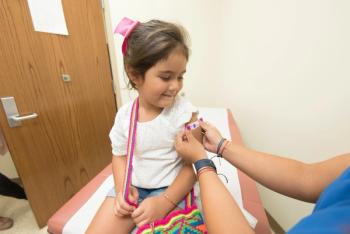Long-Acting HIV Therapy Gains Ground in Both New and Experienced Patients
At IAS 2025, the VOLITION and OPERA study data show patient preference and real-world use of injectable CAB + RPV LA, informing the treatment strategy of ViiV CMO Jean van Wyk.
Nearly 90% of treatment-naïve people with HIV chose to switch to long-acting injectable therapy after achieving viral suppression, according to findings from the Phase IIIb VOLITION study presented by ViiV Healthcare at IAS 2025. The study enrolled 145 newly diagnosed individuals who began treatment with the daily oral regimen dolutegravir/lamivudine (DTG/3TC). Once they achieved viral suppression, typically in just over four weeks, participants were given a choice: remain on daily oral medication or switch to the long-acting injectable regimen, cabotegravir plus rilpivirine (CAB + RPV LA), administered every two months. An overwhelming 89% (n=129) opted for the long-acting option at their next study visit.
Jean van Wyk, MBChB, MFPM, chief medical officer at ViiV Healthcare, explained, “This study was specifically designed to see how quickly we can get treatment-naive individuals to get to a point where they can potentially choose long-acting injectable therapy."
“They were started on a medication called Dovato, which is a combination of dolutegravir and lamivudine... the moment they became undetectable—which means that they have no virus replicating in their blood—they were immediately given the choice: do they want to stay on the daily oral medication, or do they want to switch to long-acting injectable therapy?”
Participants reached viral suppression with a median time of 4.14 weeks, and data showed that convenience was a key driver in their decision-making.“About 80% of them said it’s because they don’t want to worry about forgetting to take a tablet every day, and about two-thirds of them said it removed the worry about traveling with medication,” van Wyk added.
This strong preference aligns with outcomes from other studies and real-world experiences.“We’ve seen this in studies and in real-world evidence, and it’s just a testament to the power of choice—giving people the choice of a medication that might be best suited to them,” said van Wyk.
OPERA Real-World Data Reinforces Effectiveness in Treatment-Experienced Populations
While VOLITION focused on newly diagnosed individuals, real-world data from the OPERA cohort broadened the picture to include treatment-experienced people living with HIV, especially those with viremia at baseline.
Among 3,304 participants in OPERA, 11% (n=368) had viral loads above 50 copies/mL at initiation of CAB + RPV LA. Remarkably, 88% of these viremic individuals achieved suppression to <50 copies/mL, showing the potential of long-acting treatment even for those with complicated treatment histories.“This time, specifically, we looked at people who are treatment-experienced… but for whatever reason, it wasn't working for them and they became viremic again,” van Wyk explained.
“We had well over 300—nearly 400—people included in this analysis, and they had viremia… what we found was that, over time, they had really good responses—very good effectiveness rates from this OPERA analysis—with around 88% of individuals having an undetectable viral load.”
A separate sub-analysis of viremic women in the OPERA cohort demonstrated even more impressive results, with 92% achieving viral suppression after switching to long-acting therapy.“Again, we saw very similar and good treatment outcomes—just over 90%, 92% of women—having an undetectable viral load after they’d gone on to long-acting injectable therapy,” van Wyk said.
In addition to VOLITION and OPERA, ViiV is building a growing portfolio of real-world effectiveness data. Supporting studies such as CARLOS (Germany), COMBINE-2 (Europe), and BEYOND (U.S.) continue to confirm low virologic failure, strong adherence, and high patient satisfaction across diverse populations—including both virally suppressed and viremic individuals at the time of switch.
“That includes viremic and suppressed populations at the time of switch—again, showing really good effectiveness rates, low rates of virologic failure, and persistence on treatment over time,” noted van Wyk. As the HIV treatment landscape shifts toward personalization and patient-centric care, Jean van Wyk’s leadership at ViiV is shaping a strategy rooted in flexibility, access, and real-world insight.“It’s just a testament to the power of choice,” he said. “Giving people the choice of a medication that might be best suited to them.”
Reference
ViiV Healthcare data show 89% of treatment-naïve people with HIV choose to switch to long-acting injectable Vocabria + Rekambys from daily pills after achieving rapid viral suppression. Businesswire. June 14, 2025. Accessed June 14, 2-25. https://www.businesswire.com/news/home/20250714839509/en/ViiV-Healthcare-data-show-89-of-treatment-nave-people-with-HIV-choose-to-switch-to-long-acting-injectable-Vocabria-Rekambys-from-daily-pills-after-achieving-rapid-viral-suppression
Newsletter
Stay ahead of emerging infectious disease threats with expert insights and breaking research. Subscribe now to get updates delivered straight to your inbox.



















































































































































































































































































